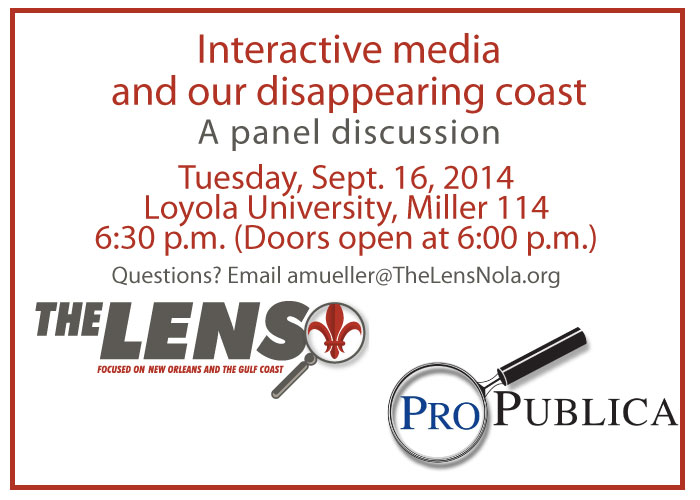Scientists say one of the greatest environmental and economic disasters in the nation’s history — the rapid land loss occurring in Southeast Louisiana — is rushing toward a catastrophic conclusion over the next 50 years.
Recently, The Lens and ProPublica launched Losing Ground, an interactive project that lets you explore the issues, including why it’s happening and what we’ll all lose if we do nothing to stop it.
Tuesday, The Lens is hosting a panel discussion offering an in-person opportunity for you to learn how the project came together, meet some of the characters in the story and learn what’s next for this long-term project.
Who:
- Earl Armstrong, cattle rancher
- Paul Chiquet, Lafourche Parish Public Library
- Brian Jacobs, ProPublica
- Ryan Lambert, fishing guide
- Bob Marshall, The Lens
- Steve Myers, The Lens
- Al Shaw, ProPublica
When:
- Tuesday, Sept. 16
- 6:30 to 8:30 p.m. Doors open at 6 p.m.
Where: Loyola University, Miller Hall 114, where Loyola Avenue meets Calhoun Street
Light refreshments will be served.
Questions: amueller@TheLensNola.org or (504) 258-1624
In case you missed it, we invite you to read the article: Losing Ground: Southeast Louisiana is disappearing, quickly.



At around the time of the height of the Greek Culture the St. Bernard Delta extended out past what are now the Chandeleur Islands. Archeological sites document that this area, and almost certainly this delta, was inhabited by native people. These people hunted and fished, they probably gave names to the many bays and bayous of their delta marsh ecology, and they probably considered it to be the land of their heritage. Core studies of the sediments from this time have found in-place cypress stumps documenting the cypress swamps in which these people lived and hunted. One of those stumps was age-dated to 2100 years old. It is now 33 feet below sea level. The subsidence rate that is necessary for this stump to be at that depth is the same subsidence rate being experienced in the wetlands today, and the wetlands of today will follow the same natural progression to open water bays that those of the St. Bernard Delta did.
The Lens and ProPublica have created a visually stunning publication that documents the subsidence of the coastal wetlands over the past few decades. These images could be used to help us better understand the patterns of subsidence of all of the historical deltas To use that publication to advance the mythology of coastal restoration and to characterize south Louisiana as being in a state of crisis not only promotes scientific illiteracy, it does measurable harm to the tourism economy of the area. Nobody wants to visit a place that is being called a catastrophe by the local media.
South Louisiana is not in a state of crisis. There is not a catastrophe. The wetlands of Louisiana are among the most beautiful places on the face of the earth. The changes that are happening to the coast are part of a natural cyclical process that has been going on since well before the St. Bernard Delta defined the outline of the coastal wetlands